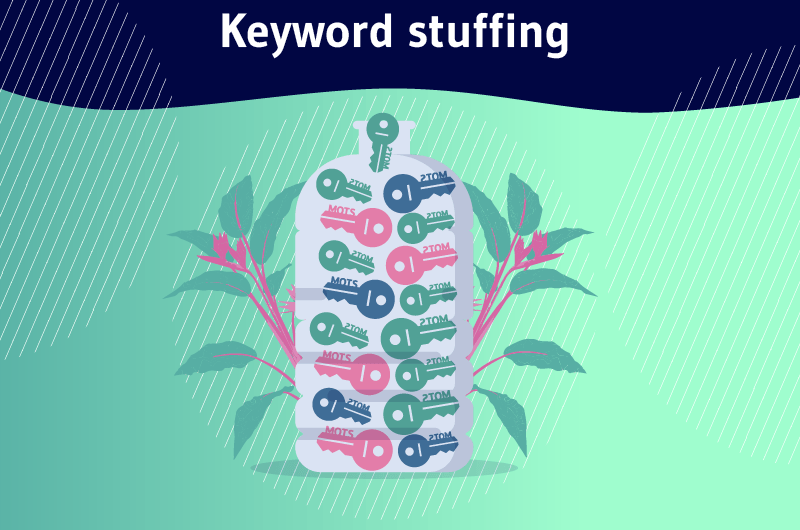Keywords Stuffing is a practice that consists in overloading the content of a web page with keywords. More precisely, it is an optimization technique for SEO designed around the idea that: More keywords gives more authority to a web page. It is considered as spamdexing or Black hat SEO. That is to say a technique consisting in deceiving the algorithm of search engines on the quality of a content in order to position it high in the SERPs.
Knowing how the algorithmssome webmasters are often tempted to manipulate search engines. This sometimes forgetting the importance of the user experience and the possible risks that their practices could have on their website at a given time.
The accumulation or stuffing of keywords fits perfectly in this context and that’s why it is useful to talk about it.
- What is keyword stuffing really about?
- How does it harm the natural referencing of websites?
- How to fix it?
These are some of the questions that you are probably asking yourself about the concept of keyword accumulation. They will be addressed in the following lines
So follow!
Chapter 1: What is keyword accumulation or keyword stuffing?
In this first chapter, I will explain what it is
- Keyword accumulation;
- Its manifestations ;
- The consequences it can have on your website
1.1 – What is the accumulation of keywords ?
The accumulation of keywords or keyword stuffing is a practice that consists in filling the content of an article or a web page with keywords
It is based on the idea that the authority of a web page or an article increases for a keyword, when this keyword is used several times on a web page or in a blog post
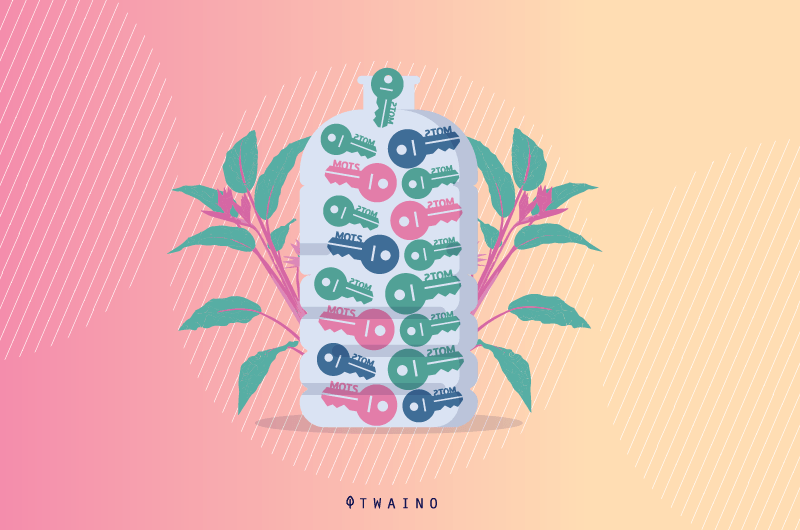
The objective behind this practice is to make the algorithms in charge of ranking results in a search engine believe that they are in the presence of quality content

This implies that the technique of keyword stuffing forces the webmaster to work primarily for the algorithms and not for the Internet users who will come to his site
It is precisely for this reason that he finds himself in trouble later
Indeed, by designing the pages of his site only to please the algorithms, the webmaster neglects and forgets some recommendations of the search engine
This is for example the requirements that are made to him regarding the writing of a quality content.
1.2) How do problems of keyword accumulation manifest themselves?
You will have understood, the keyword stuffing is the consequence of an excessive repetition of a keyword on the page of a website
In general, keyword stuffing is the use of a list of keywords or a series of list inserted repeatedly in the content of the site
It can be:
- Meta tags
- Visible content (articles) ;
- Anchor texts ;
- Source code ;
- Etc.
The insertion of these keywords can also be done using different techniques such as the use of
- The noscript tag ;
- Hidden text
- Words or blocks of words that are not relevant to the web page or to the subject matter
All this makes the content of the page unreadable and uninteresting for the Internet users
In some cases, the content of the site is meaningless, because it is designed only to impress the search engine
Here are some examples of keyword stuffing

In any case, it should be noted that keyword stuffing has not always been a problem for websites
In fact, at a time when search engines worked in a simpler way, this practice worked well and webmasters were not worried.
As search engines evolved and in their concern to display better results to Internet users’ queries, they implemented algorithms algorithms that are more and more efficient
These algorithms are even capable of penalizing sites that do not respect the rules of good practice that search engines set for webmasters
When webmasters go against these practices, they are considered as practicing prohibited optimization techniques, ie the Black hat SEO
Now that you have an idea of what keyword hoarding is and how it manifests itself, find out what consequences it can have on your website.
1.3. The consequences of keyword stuffing
Keyword stuffing is not without consequences on the natural referencing of your site
Google officially states that “stuffing pages with keywords or numbers leads to a negative user experience and can harm your site’s ranking”
It negatively impacts your SEO efforts by contributing to your site’s decreased performance in the SERPs, but also, exposing it to Google penalties

So, as you persist in using this practice, you will see
- A decrease in organic click-through rate;
- High bounces
- The lack of sharing of your content on social networks;
- Etc.
The accumulation of keywords can also affect the user experience on your site. As a result, your site will no longer interest Internet users.
Among other consequences that your site risks, you can have
- Its demotion in the SERPs;
- The partial or complete de-indexation of the site in the search results.
All this is proof that keyword stuffing is a very serious problem for the natural referencing of a website.
This observation can be supported by the following two ideas
First idea: Search engines only rank quality content
The effectiveness of a search engine depends on its ability to provide the best results to Internet users
It is on this basis that as soon as a user performs a search, the search engine scans the web and displays the best results corresponding to his request.
For a search engine like Google, the quality of the content is important
This is exactly why Google, in guidelines for webmastersemphasizes what is quality content.
It does not expressly define it, but makes it based on a number of guidelines to respect. These guidelines can be grouped into two categories: What to do and what not to do.
The accumulation of keywords is rightly identified as one of the things not to do.
Idea #2: Search engines are constantly improving their search algorithms
In order to provide relevant search results that send users to quality content, the search engineslike Google, search engines are constantly improving their search algorithms. That is, their operating system
As you can imagine, this ranking system has no other goal than efficiency and relevance
This is why each result goes through a specific process which includes
- Analysis of search terms;
- Matching search;
- Ranking of pages according to their usefulness;
- Displaying the best results;
- Taking into account the search context.
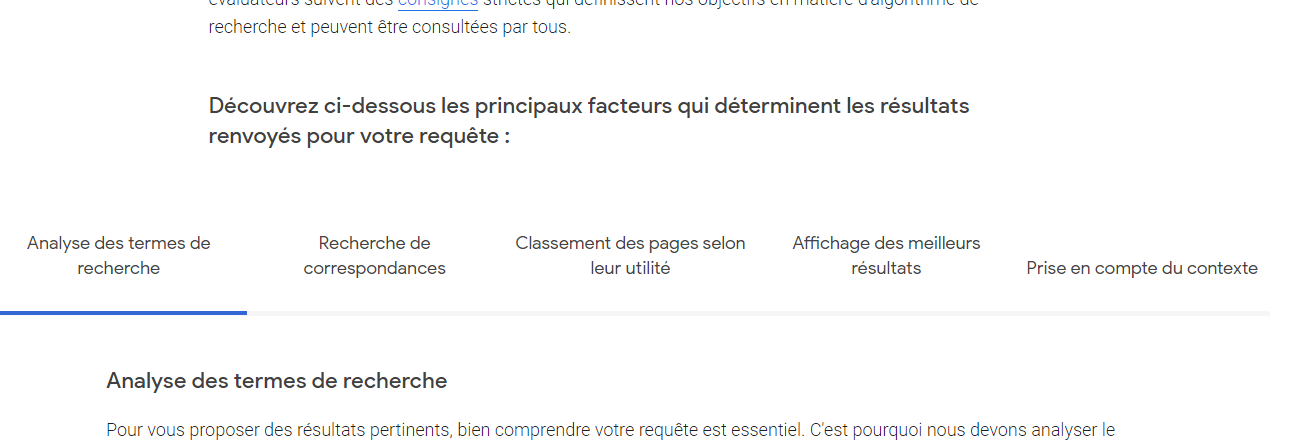
In addition, there are a huge number of factors that Google uses to sort and rank the results in its in its index
Now that you have an idea of the consequences of keyword stuffing, I invite you to discover some solutions to avoid it.
Chapter 2: How to avoid keyword stuffing?
Here, I explain how to solve keyword stuffing problems, but first, it seems necessary that I expose you how to identify it
2.1. identify your keyword stuffing problems
Content that is subject to keyword stuffing can be identified based on the various problems that this type of content can reveal
Generally, when faced with keyword-stuffed content, we notice
- A high density for the appearance of the keyword a high density for the appearance of the keyword: In a content stuffed, you will find that the keyword appears several times. According to the site Alexa blogthis density should remain below 2%;
- The content does not meet the expectations of users the content does not meet what it claims to provide a solution;
- Users have difficulty reading or understanding the content the content is written in a language that is inaccessible to the user, the text is often not organized and lacks coherence
In addition, different tools can be used for identification. For example, these are
2.1.1 Keywords Density analysis tool
This free tool allows to perform the analysis of the density of the keywords used on a web page
It also allows to proceed to a better distribution of the keywords.
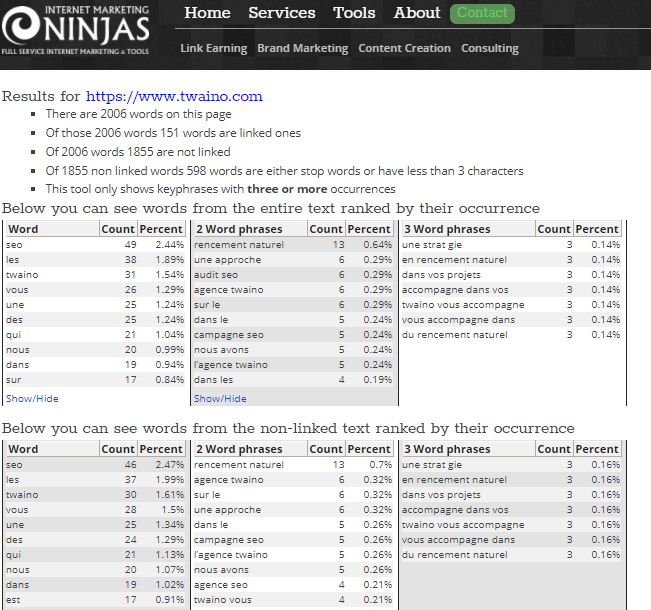
To use it, you just have to enter the URL of the page you want to analyze in the space reserved for this purpose. The analysis of the URL then allows you to collect several pieces of information such as
- The total number of words on the page ;
- The number of linked words;
- The number of unrelated words;
- The number of empty or very short words used in the unlinked text.
2.1.2. Seo review tool
The SEO review tool is also a tool for checking the density of keywords
When you submit the URL of your page or content to be analyzed, it extracts all the words and determines their density
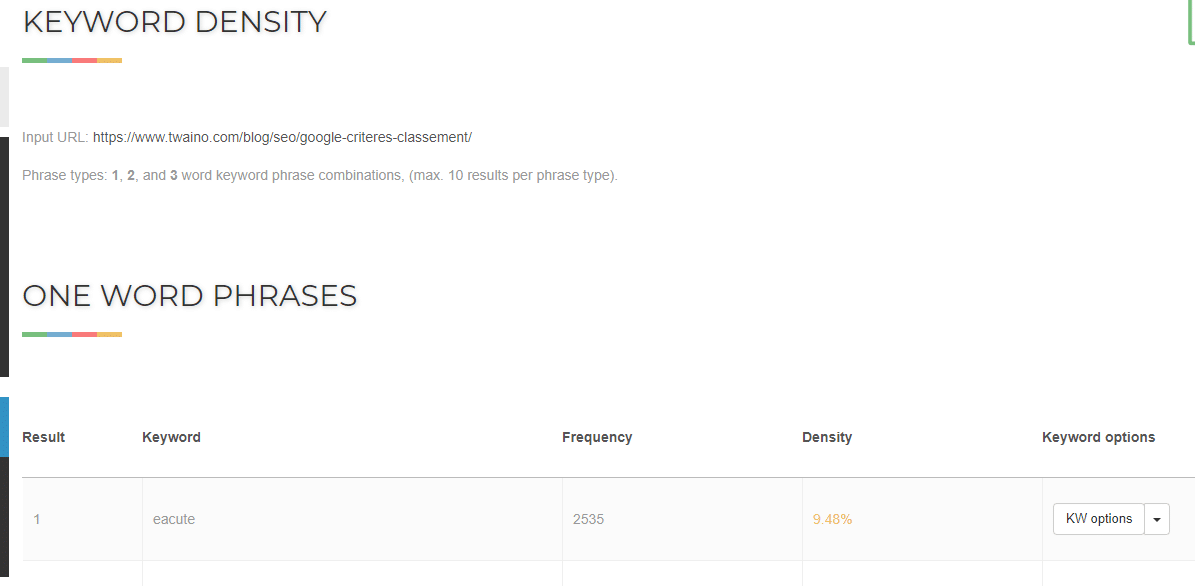
All this allows it to check if a page is over-optimized.
You can also use it to determine which keywords your competitors use frequently
2.1.3. Copywritely
Copywritely is an online keyword density checker that allows webmasters to detect if their content is subject to keyword stuffing
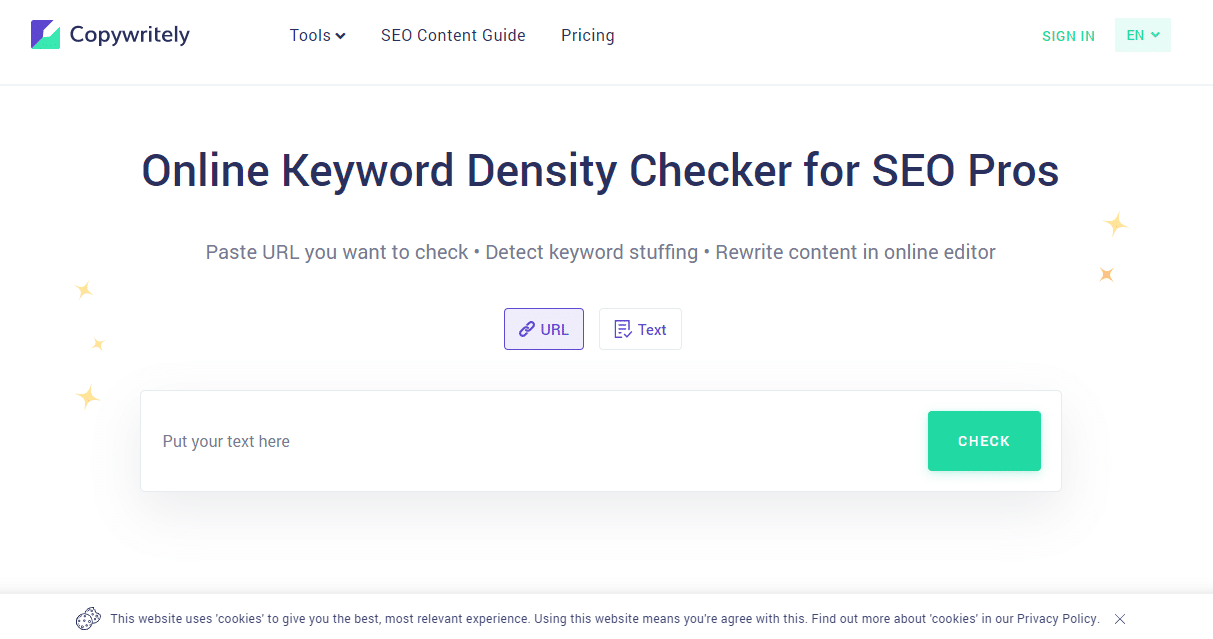
But this is not the only feature. Apart from keyword detection, the tool has a text editor that allows you to rewrite online content
It is not free and offers monthly subscriptions ranging from $18 to $67.
2.1.4 GeoRanker
GeoRanker is also a tool for checking keyword density
It determines in percentage the number of times a keyword or phrase is visible compared to the total number of words on the web page.
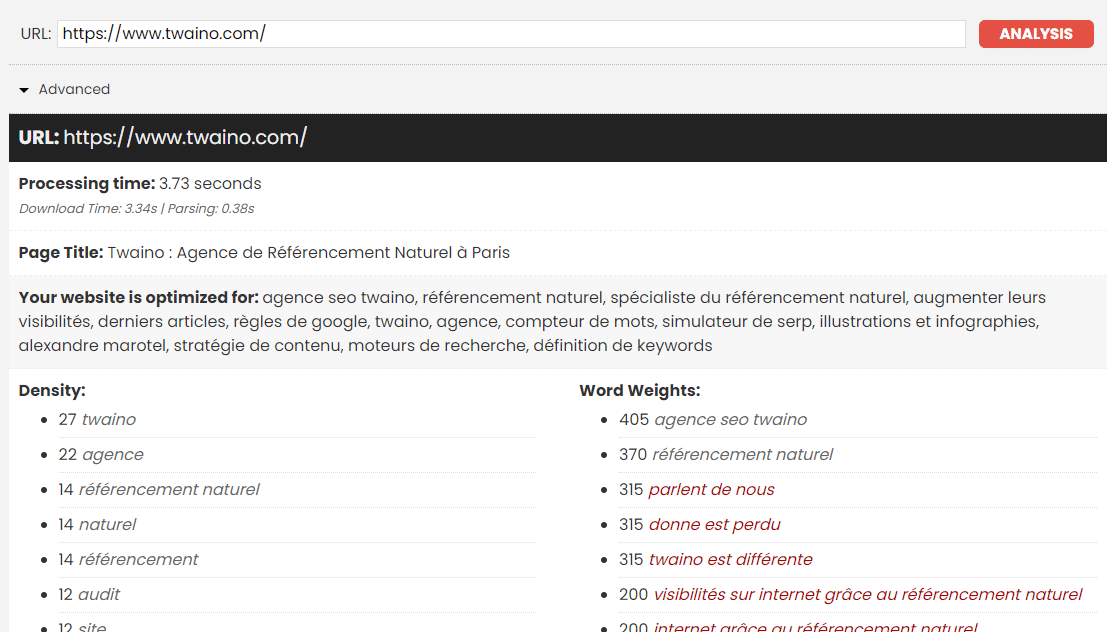
You can therefore use it to check the relevance of your pages. It is not free, but you can benefit from a free trial period of 7 days
2.2. how to avoid Keywords Stuffing and succeed in keyword optimization?
The point here is not to avoid using keywords in your content, but rather to use them with great moderation. Here is what google advises advises on the subject: “Focus on creating useful content filled with relevant information that makes appropriate use of keywords.”
If you want a page to rank well for a specific keyword, optimize the page for that keyword instead of “overloading” it
The trick is to use the keyword where it matters most to search engines, while keeping the text natural and valuable to readers.
Without further ado, let’s look at some steps that can help you solve this keyword stuffing problem and properly optimize your web page:
2.2.1. De-optimizing your web page
When you face a problem of keyword accumulation on one of your web pages, you can solve it by proceeding to the deoptimization of this page
In a more concrete way, it will be a question of
- Analyze the entire page;
- Identify the SEO practices used;
- Identify the way in which the keywords are optimized on this page and proceed to their upgrade.
If in the meantime, you have optimized pages on keywords by operating in a mechanical way, it would be good to change the deal by also working on the semantics of the keyword
2.2.2. Assign a unique search intent per web page
When creating your content, make sure to dedicate each of your web pages to a unique topic or search intent
In other words, always opt for a new unique search intent and, therefore, a new unique search term
This will prevent your pages from fighting for a single spot in the SERPs: the so-called keyword cannibalization. This way, search engines will easily understand the main topic of your pages.
2.2.3. Search for keywords in an efficient way
Before writing your content, don’t forget to research the keywords that you will use in your content

To this end, various research tools are at your disposal. Once you have found the keywords, all you have to do is use them in the best way to produce good results
Learn how to do your keyword research by consulting my previous article designed for this purpose.
2.2.4. Create longer content
Content is more likely to attract the attention of search engines when it covers a topic in detail
Generally, the longer a piece of content is, the more room there is to cover various relevant keywords. Best practice dictates that your content should be at least 300 words for Google to notice it and give it appropriate treatment in the SERPs.
2.2.5. Identify and place the target keyword in the most useful places
To make your SEO strategy effective, there are places where you should put the keywords that give your strategy more impact
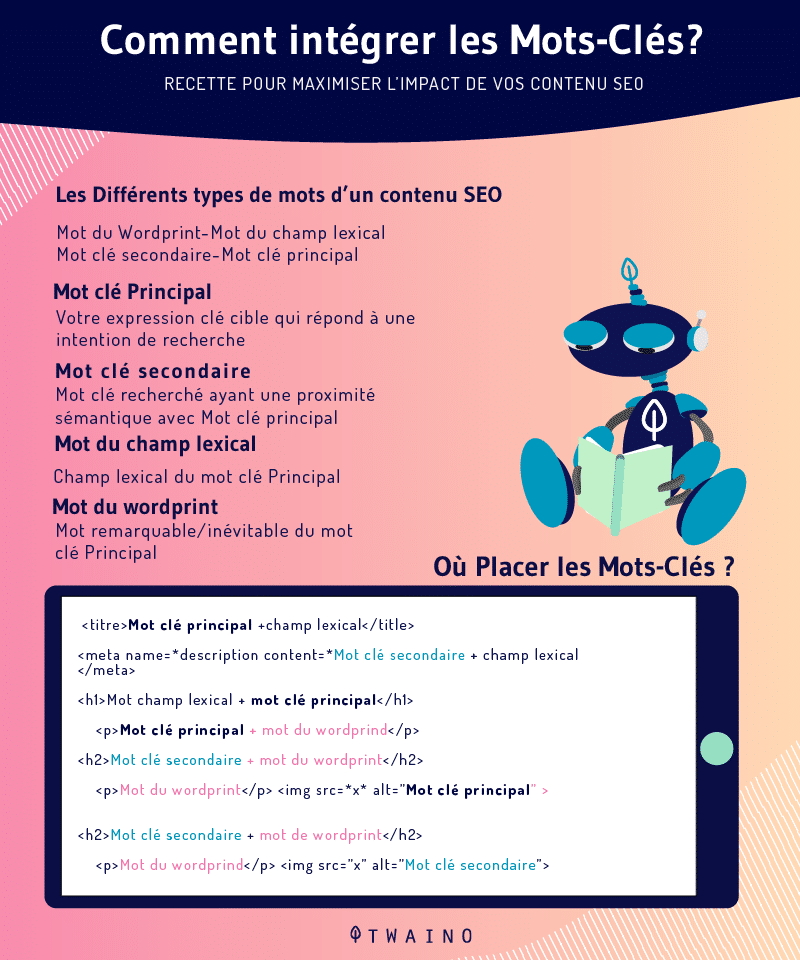
Look for these locations and make sure you put the keywords you want to use for the content.
These locations are
2.2.5.1. The URL of your web page
The URL is the address by which you access your web page. To inform the search engine or give an idea about the content of this page, favor URLs that immediately inform about the content rather than those with characters or numbers
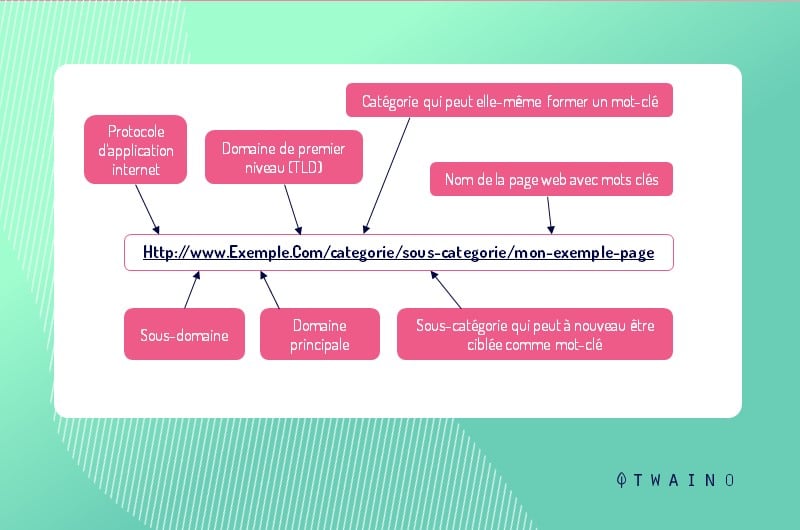
Reconfiguring your URLs by replacing characters with keywords will make sense to both the search engine and the user.
2.2.5.2. The title tag
It contains the title and must therefore inform about the central subject of your page.
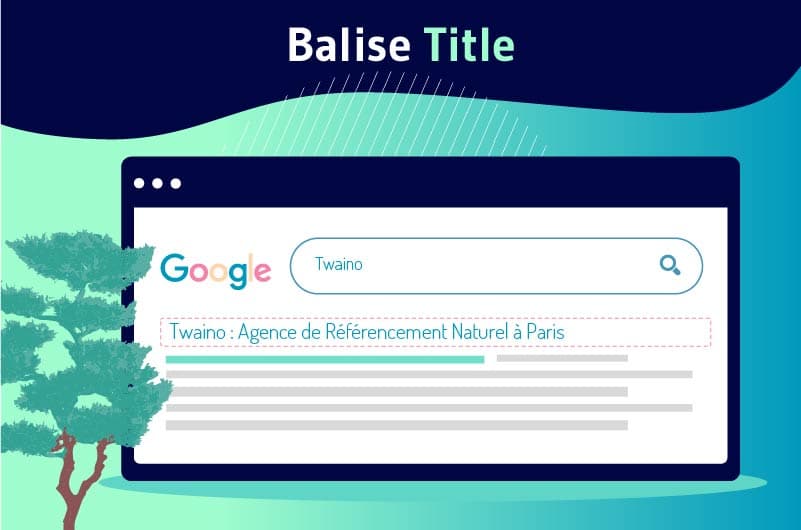
It is the title that is displayed in the first line of search results and indicates to Internet users the title of your page. It is therefore recommended to use the main keyword of your page at this level.
2.2.5.3. The Meta description
The Meta tag is displayed as a second line in the SERPs

Its role is to further inform Google about what your web page contains. It also allows Internet users to decide whether or not to display your site. You can also use your main keywords at this level.
2.2.5.4. The content
As a factor of ranking of your site by Google, the content must also be optimized around the keyword. However, it is especially at this level that it is important to avoid keyword stuffing
2.2.5.5. The titles h1..h2..h3
The tags h1 to h6 represent the subheadings of your page. In other words, all the subdivisions of your content.
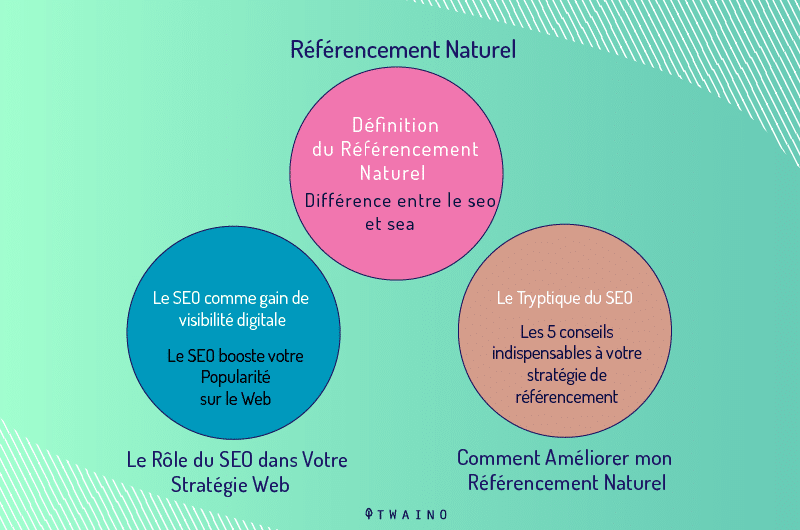
You can also insert at this level some keywords or even associated or secondary keywords
2.2.5.6. The anchor text
The anchor text is the clickable text that you insert in your content and that refer either to another site or to another page of your site.

For each anchor that you will use in your content, avoid using the same words as much as possible. This may arouse the suspicion of certain algorithms that may penalize your page
2.2.5.7. The ALT tag of images
Although images are not textual elements, you can also optimize them for your keywords

To do this, you will need to use Alt tags to explain to the search engine that such and such an image is related to a specific page
2.2.6. Maintain a good keyword density
When creating your content, try to balance the text with the target keyword and related keywords. Insert the keyword only where and when it feels natural in the overall flow of the text. But what is the limit of keyword density on a page?
The best practice would be to stick to an optimal keyword density of about 2%. This would allow you to maintain a good ratio of target keyword/total number of words
Pro Tip: If you use WordPress as your CMS, you can use the plugin Yoast SEO plugin to keep an eye on your keyword density percentage.
2.2.7. Avoid repetition and convey your message in a natural way
Constant repetition of keywords on your page increases the risk of accumulation
Moreover, it makes your content unreadable or even useless. I therefore recommend that you avoid this approach by focusing instead on
- Associated keywords
To ensure the visibility of your website, you can also use associated keywords
Still called secondary keywords, these keywords have a link with your main keyword
They are usually synonyms, variants or expressions that have a semantic link with the main keyword
This allows you not only to avoid the accumulation of keywords, but also to increase your chances of ranking when the Internet user uses words similar to your keywords
- The LSI keywords
Apart from related keywords, you can use LSI keywords
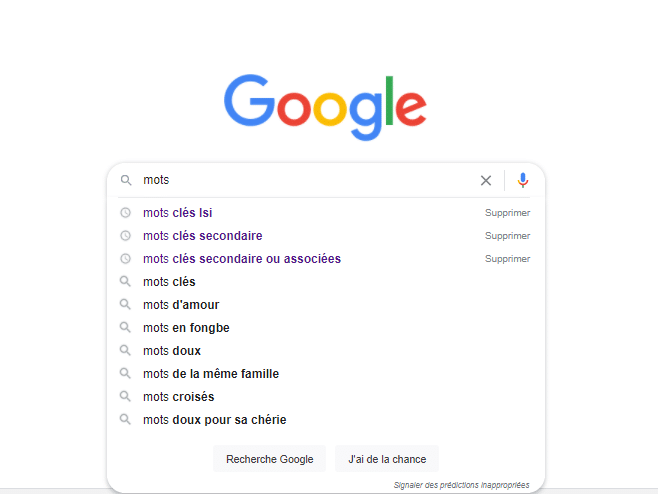
Known aslatent semantic indexingthese keywords are a set of words related to the main topic of your content
According to backlinkothey are conceptually related words that the search engine uses to better understand a query
When used, they reinforce the meaning of your content and help search engines to better understand the central topic of your site
- Long tail keywords
You can also use long tail keywords.
This is a category of words that are longer and less competitive than the main or secondary keywords
They are composed for the most part of three or four words and constitute a set of words or expressions entering the lexical field of your content.
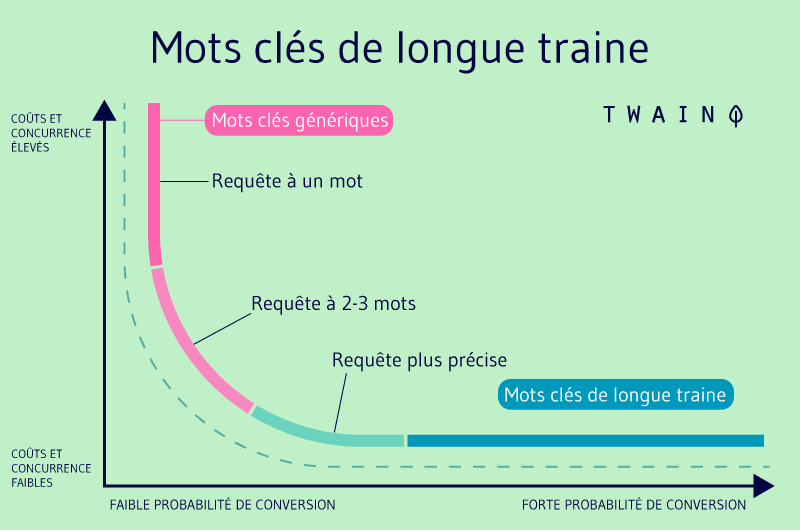
Their use will allow you to avoid keyword stuffing, however, you must be careful not to use the same expression several times throughout your article. This may also create a situation of keyword accumulation
In fact, whether it’s related keywords, ISLs, synonyms or even long tail keywords, you should not focus your attention on a single word
In fact, when using these words to avoid having your content filled with keywords, your strategy should not be to stay focused on one phrase or secondary keyword
Instead, you should use these keywords in different and diverse ways to break the monotony that often leads to keyword stuffing.
Pro tip: The Keyword Suggestion Tool (can be useful, as it allows you to enter any keyword and get a list of similar, related and long tail keywords.
2.2.8. Bonus: Check your On-page SEO
Now you know how to avoid keyword stuffing and how to properly send positive signals to search engines about what your page is about
But, you also need to consider other key On-page SEO points to help your page rank well in the SERPs for the target keyword
To do this, once you publish a new web page, make sure it is fully optimized for the selected target keyword by performing an SEO audit

Chapter 3: Other questions about Keywords Stuffing
3.what is Keyword Stuffing?
Google officially defines keyword stuffing as the practice of loading web pages with numerous keywords in order to manipulate a website’s ranking on search engine results pages (SERPs).
3.2. Can keyword stuffing help my website?
As a general rule, stuffing your web page with keywords will not help your search result ranking. On the contrary, it can hurt your SERP ranking, because keyword stuffed content is just annoying for users
Remember that search engines tend to favor pages that create a great user experience
If you just repeat the same keyword over and over again on a page, chances are Google and other search engines will penalize it and lower its ranking
3.3. Does keyword stuffing still work?
In the past, Webmasters used Keywords Stuffing in order to trick the search engine ranking algorithms. This was done by inserting several keywords in the same content in order to obtain a better ranking for these keywords
However, this method is obsolete and does not work nowadays. Not only does Google no longer give good rankings to pages using this technique, but it also penalizes them.
In summary
Accumulating keywords is not a SEO solution that a company or an individual who wants to increase his results should use
Whether you are an individual or a company, you should focus on the best way to use keywords in your content
In this article, you have seen that a bad use of the keyword can be the cause of a penalty from the search engines.
If you are already suffering from this problem, you now have some ideas to change the situation
If you think that I missed some or that I forgot to deal with some aspects, don’t forget to comment directly on this article!
See you soon!

